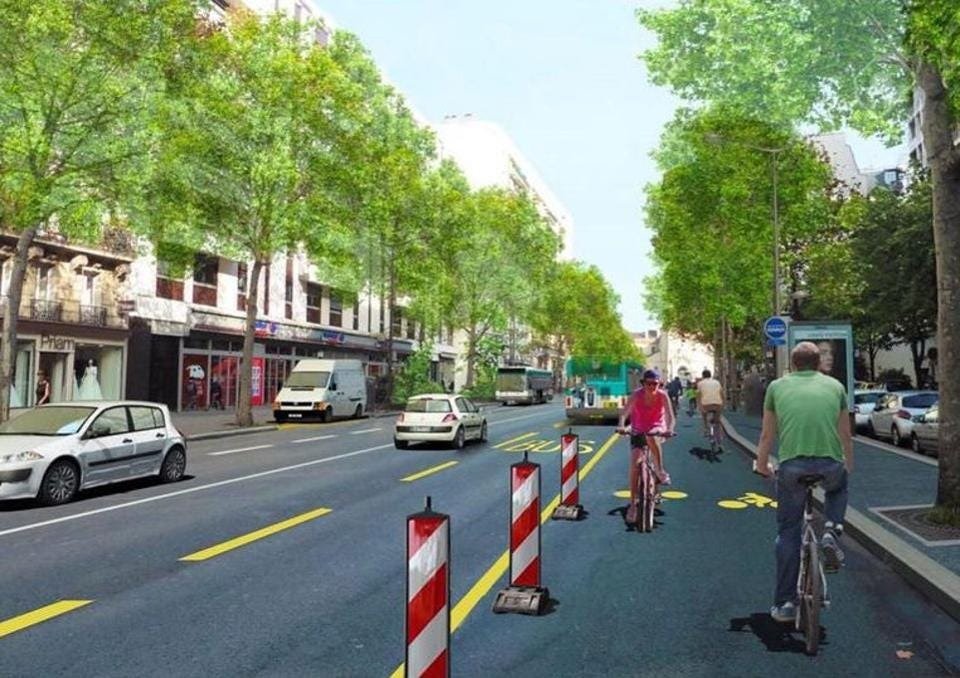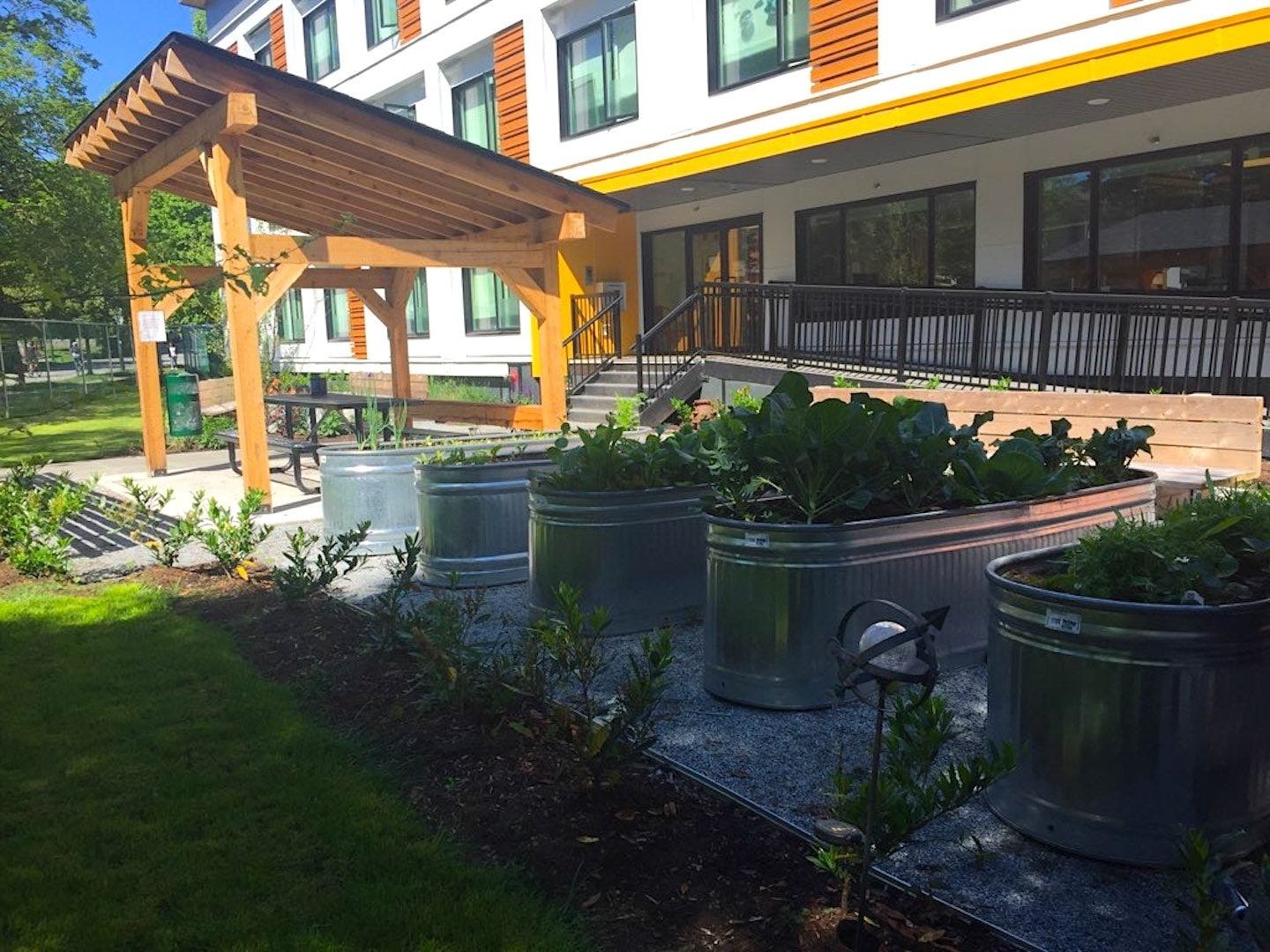The pandemic is changing the way we use city spaces — for good
By Charles Montgomery and Tristan Cleveland
On a blustery spring day, Beacon Hill Park seems a world away from the pandemic crisis sweeping the globe. Here, in the heart of the oceanside city of Victoria, Canada, the maples are budding and the rain taps gentle on the glass roof of the park nursery. But inside that greenhouse, a radical idea has taken root.
The parks facility usually focuses on growing flowers for the hanging baskets that line Victoria’s streets. Not this year, explains Victoria Mayor Lisa Helps, as she kneels down to peer through a miniature forest of sprouts. The flowers have been cleared away to make room for vegetables. Today, sweet basil and black cherry tomato sprouts push towards the light.
“We call this relief by vegetable,” says Helps. “People have lost jobs. They need healthy food.”
The city’s nurseries will nurture as many as 75,000 edible plant starts this summer. The plants will then be distributed to people affected by the COVID-19 pandemic, so they can harvest their own zucchini, broccoli, kale and other greens.
“Back in the depression, City staff grew thousands of pounds of potatoes in this park, and donated them to the old mens’ homes and the orphanage. These aren’t new ways. They are old ways.”
The initiative has germinated across the city. Local non-profits are cultivating vegetables on city boulevards. Community gardens on public land are expanding. Even the Province of British Columbia’s Lieutenant Governor (the ceremonial head of government) is replacing the sod on her mansion’s lawns with a “Victory Over COVID Garden” of food crops to share.
Victoria Mayor Lisa Helps inspects vegetable seedlings at a city greenhouse once reserved for growing flowers.
Victoria is not alone. The COVID-19 pandemic is precipitating a head-spinning shift in the way cities use urban public space and other infrastructure. Parks, streets, parking lots, golf courses and buildings around the world are being reinvented and transformed in ways that would have been unthinkable before the crisis, even though they address problems that cities have been grappling with for years. Food insecurity. Safe streets. Public health. Homelessness. It’s all on the table now. Cities are realizing that their challenges are overlapping and interconnected. Responses to the pandemic can actually make cities happier, healthier and stronger in the long run.
Happy streets
When COVID-19 cases started popping up in Colombia in mid-March, Bogotá Mayor Claudia López realized that her city had a head start on at least one mitigation measure. The World Health Organization had advised that walking and cycling were the safest means of getting around during the pandemic. For years, Bogotá already closed its main roads to cars on Sundays so people could walk, bike or roll freely across the city.
As the virus bore down on the city, López realized it was time to super-size the program.
Within days, Bogotá opened nearly 47 miles of new temporary bike routes, adding to 340 miles of paved protected paths. Almost 17 miles of automobile lanes were converted to bike routes overnight.
The coronavirus crisis has accelerated an array of creeping urban transformations. Among the most dramatic has been the handover of city streets to pedestrians and cyclists. Oakland, California, which is using simple barriers to restrict car access to 10 percent of local streets, resulting in a surge in walking, cycling, skateboarding and social-distance dancing. Salt Lake City crowdsourced a network of open streets routes from residents. Edmonton, Perth and Boston have automated crossing signals so that pedestrians don’t have to touch “beg buttons” that may be contaminated. Lithuania’s capital, Vilnius, is handing over much of its public space to bars and restaurants so they can serve customers while social distancing.
As the pandemic is handing over streets normally reserved for cars to bicyclists and pedestrians, it is simultaneously showing us the profound effects reducing car use can have. In California, traffic accidents — as well as crash-related injuries and deaths — fell by half in the weeks following the first shelter-in place order. Los Angeles experienced its longest stretch of clean air on record. People will return to their cars. But the local street closures will fundamentally change how people see their cities, says Lydon. “People are already asking: ‘How much pollution do we want to invite back into our lives? How much congestions do we want? How many crashes a year do we want? How many fatalities do we want?’”
A growing number of cities have signalled that at least some of the alternations are here to stay.
More than a hundred cities across France have rolled out temporary bike lanes. Now, that country has announced its intention to make sure residents keep riding once the crisis has passed. Under a $22 million plan announced by the Minister of Ecological Transition, going forward, every French citizen will be entitled to free bicycle repairs of up to 50 euros ($55 USD) from a network of 3,000 mechanics who will be directly reimbursed by the government.
Paris is creating 650 kilometres of pop-up “corona cycleways” for travel once the lockdown ends, and has converted one of its major central roads, the Rue di Rivoli, into a cycleway, a change Mayor Anne Hidalgo has said will be made permanent if successful.
Pop-up “Corona Cycleway” on Avenue Leclerc in Paris, imagined by Paris en Selle .
Milan, too, has announced that over 20 miles of cycling infrastructure put in place for the pandemic will be kept in place post-lockdown. The city is working with former New York City Transportation Commissioner Janette Sadik-Kahn to facilitate the transition. “The pandemic challenges us, but it also offers a once-in-a-lifetime chance to change course and repair the damage from a century of car-focused streets,” Sadik-Kahn told the BBC. “Cities that seize this moment to reallocate space on their streets to make it easier for people to walk, bike and take public transport will prosper after this pandemic and not simply recover from it.”
It took a pandemic to bring real urgency to the healthy streets movement. Fortunately, cities are now making permanent changes.
This isn’t just good for people’s health. It’s good for business: Bike lanes are shown to boost retail sales and jobs wherever they pop up.
By shifting streets from inefficient car space to space for people, cities can rebuild hard-hit local economies. That’s why the government of New Zealand has offered to reimburse cities for 90% of the cost of turning streets into permanent social spaces in that country. Milan, Italy, is explicitly taking streets back from cars as part of its pandemic economic recovery strategy. “If everybody drives a car, there is no space for people, there is no space to move, there is no space for commercial activities outside the shops,” Marco Granelli, a deputy mayor of Milan, told The Guardian. “That’s why it’s so important to defend even a part of the economy, to support bars, artisans and restaurants.”
Finding shelter
The pandemic has shifted our perceptions. The impossible now seems possible. We can do more with the resources we have. In this moment of possibility — of urgency — some governments are taking care of vulnerable populations in ways they never have before..
There are 550,000 homeless people in the USA and Canada alone. Even without a pandemic, homeless people face greater risk of disease and other health problems: life expectancy for homeless women is a shocking 43 years, while for men it’s just 47 years. Now homeless people are doubly in danger. Crowded shelters and encampments risk becoming nexi of contagion.
With crisis comes opportunity. The pandemic has caused an almost-total shutdown of tourism. So governments are taking advantage of empty hotel and motel rooms in order to save lives. In California, the government has identified a whopping 15,000 hotel rooms for use by the homeless.
Back in Victoria, where 360 people were living rough in public parks, the city and the provincial government teamed up to move hundreds into hotels and motels, where they will receive meals, laundry, washroom facilities, health-care services, and addictions treatment — exactly the kind of support people need to get their lives back together again.
But what happens when the pandemic ends, and hotels start to fill up with tourists again? British Columbia is demonstrating one answer that is both fast enough for pandemic response, and beneficial in the long term. Before the pandemic, the government looked at its underused public land and asked: How could we build housing here to get people off the streets as fast as possible? The solution was modular housing, where companies build apartment units in factories, and then assemble them on-site like lego blocks. This enables construction speeds that are almost unheard of in modern cities. For example, the government started construction on a new building for homeless people in Vancouver in December 2019. This March, during the height of the pandemic, 58 homeless people moved into their new homes. Social workers report that with supports, residents experience an almost-miraculous emotional and physical recovery.
In British Columbia, modular housing apartments such as this building in Vancouver are being built as a rapid response to homelessness. They can be constructed in as little as three months.
This, insists Victoria Mayor Helps, is the crucial next step for the homeless people temporarily using hotel rooms. (A new modular apartment for Indigenous women is opening in Victoria in July.)
Most cities have land that could be used for modular housing. But these permanent solutions require funds and effort from every level of government. And they require a change in attitude from all of us. These two shifts are actually happening right now: The circle of empathy, of common cause, is widening at the same time that governments are looking for shovel-ready projects for massive economic stimulus programs.
The change in heart is head-spinning. Toronto Mayor announced in a virtual council meeting on April 30 that the virus is sweeping through its shelter system. In response, the city will follow the BC model, and fast-track a 250-unit modular apartment building for the homeless. The first 110 units will be ready for occupancy by September. And the city has launched a search for sites to build even more.
All over the world, we are using this energy to ensure that our cities work better for everyone. Cities are looking at our parks and seeing the potential for them to keep people fed and healthy. They are realizing that our streets are public spaces to be shared. They are recognizing that public land can, and should, provide a home for those who have none. And they are realizing that they can change for the better, permanently.
“We are not going back to normal after this. Normal wasn’t that great for a lot of people, or the planet,” says Helps. “That’s why we are not talking just about ‘recovery’ from covid. We are talking about reinventing the city.”




